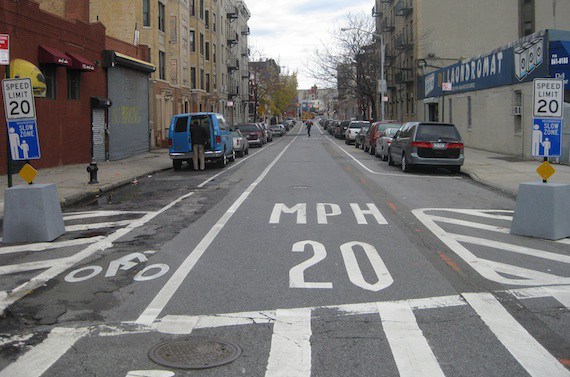London’s Slow Zones Save Lives and New York’s Don’t. Here’s Why.
In New York's slow zones, speed humps are the only physical traffic calming measure. London uses a greater variety of traffic calming measures, installed more intensively.

New York’s quick and cheap approach to creating “neighborhood slow zones” isn’t working, according to a new paper from Columbia University graduate researcher Jonas Hagen.
NYC DOT launched its slow zone program in 2011, inspired by a similar effort in London to create 20 mph zones. There are now 28 slow zones across the five boroughs, each encompassing an average of 25 city blocks.
While the program generated enthusiasm from neighborhood groups and created a template for residents to organize for and opt into DOT traffic-calming efforts, the implementation wasn’t robust enough to reduce fatalities and injuries, Hagen concludes. But the London program, which included more physical street design changes, led to a measurable reduction in severe traffic collisions.
Hagen analyzed crash data before and after the implementation of 18 slow zones for his doctoral research paper, “Calming New York: An Examination of Neighborhood Slow Zones” [PDF]. He found no significant change in the rate of traffic injuries in the areas with slow zones compared to areas with no slow zones and similar street widths, street designs, and traffic patterns.
In those 18 slow zones, overall traffic fatalities and injuries fell 10 percent, primarily among motor vehicle occupants. Injuries to people walking or biking actually increased 6 percent. The control streets saw statistically similar trends.
In London, the effects of 20 mph zones were different, preventing dozens of fatalities or severe injuries each year, according to the British Medical Journal. Hagen credits the more intensive traffic calming measures installed in London.

In New York, slow zones rely on three tools: pavement markings highlighting the speed limit, speed humps, and “gateway” signage telling drivers they are entering a slow zone. DOT later moved the gateway signs from the roadbed to the sidewalk, leaving the speed humps as the only physical traffic calming measure.
More robust measures in the city’s toolkit, like curb extensions or expanded sidewalks, were not part of the program. This enabled implementation to proceed quickly, without involving the Department of Design and Construction, but at the expense of effectiveness.
In comparison, London added raised crosswalks, raised intersections, curb extensions, pedestrian refuges, traffic diverters, mini-roundabouts, and other traffic-calming measures as part of its 20 mph zone program. And these interventions are installed at five times the rate per mile of street as New York’s speed humps.

Under the de Blasio administration, DOT’s focus has shifted away from the Neighborhood Slow Zone program and toward arterial streets. Given the agency’s limited resources, that makes sense, since major streets like Queens Boulevard and Fourth Avenue have higher rates of traffic injuries and fatalities than residential side streets. The slow zone program, which relies on speed humps that aren’t permitted on bus routes, didn’t touch wider roads.
“The DOT has a pool of engineers that work on all traffic safety projects in the city, so when something like neighborhood slow zones becomes less of a priority, the agency will be reluctant to put precious resources on a lower-priority program because their pool of engineers is finite,” Hagen said.
But smaller local streets are still places where people walk and bike, where kids play, and where traffic endangers people. As London’s example shows, a neighborhood traffic-calming program with sufficient resources can make a significant impact.
Hagen thinks the Neighborhood Slow Zone program provides a good blueprint that the city should return to for neighborhood-level traffic-calming efforts.
“This program isn’t perfect, but I think it’s a good start for area-wide traffic-calming in New York,” he said. “The zones exist, the mechanism to implement the zones exists, and you could decide to implement a more robust [program].”
“Raised crosswalks, raised intersections, mini-roundabouts, curb extensions, landscaped curb extensions — These are measures that we see the DOT implementing in other places, so it’s possible.”